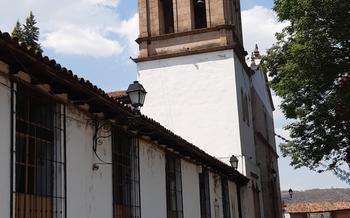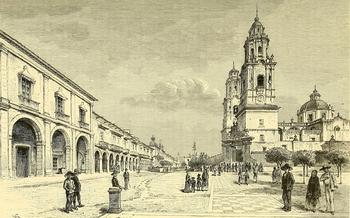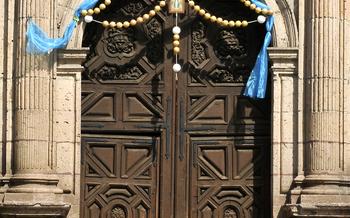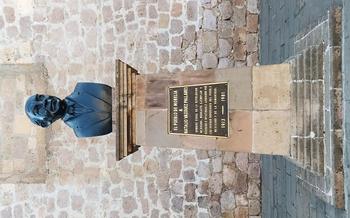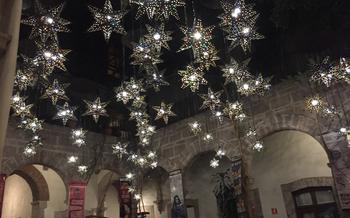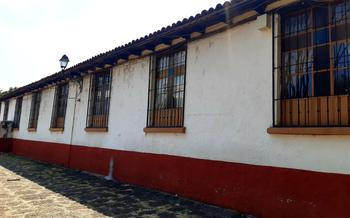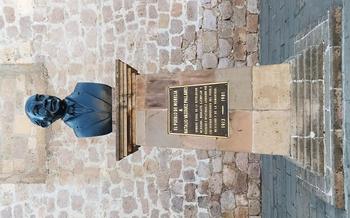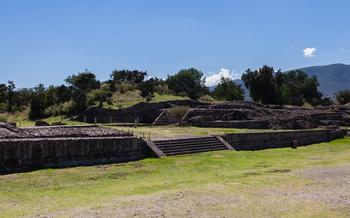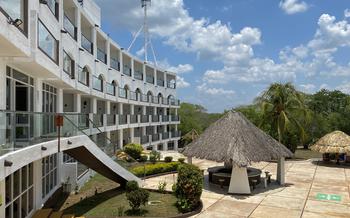
Tingambato Archaeological Site
- Tingambato Archaeological Site: An Overview
- Exploring the Ruins
- The Ball Court
- The Temple of the Yácatas: A Sacred Place of Worship
- The Museum
- Festivals and Events
- Hiking Trails
- Picnicking and Camping
- Local Cuisine
- Handicrafts and Souvenirs: Expressions of Purépecha Heritage
- Cultural Workshops: Immersing in Purépecha Traditions
- Photography Tips
- Insider Tip: The Hidden Cave
Tingambato Archaeological Site: An Overview
The Tingambato Archaeological Site is a fascinating window into the rich history and culture of the Purépecha civilization. Located in the state of Michoacán, Mexico, approximately 90 miles northeast of the city of Morelia, Tingambato is believed to have been a significant ceremonial and political center for the Purépecha people, who inhabited the region from the 14th to the 16th centuries. The site encompasses an area of over 100 acres and features a diverse range of structures, including temples, pyramids, a ball court, and residential areas. Tingambato's unique architectural features, impressive petroglyphs, and well-preserved ruins make it a must-visit destination for anyone interested in Mesoamerican history and archaeology.
To get to Tingambato from Morelia, you can take a bus or rent a car. The drive takes about two hours and offers stunning views of the surrounding countryside. Once you arrive at the site, you'll be greeted by a friendly staff who can provide you with a map and information about the different structures. The entrance fee is minimal, and the site is open to visitors every day of the week.
Exploring the Ruins
Tingambato boasts a remarkable collection of structures, each serving a distinct purpose and showcasing the architectural ingenuity of the Purépecha people. The most prominent feature is the Temple of the Yacatas, a ceremonial center that served as a sacred place of worship. Its unique circular shape and concentric terraces symbolize the cycles of life and the universe. The Pyramid of the Sun, the largest structure at the site, served as an astronomical observatory, aligning with the movements of the sun and stars to mark significant dates in the Purépecha calendar. The Ball Court, a crucial element of Mesoamerican culture, is meticulously laid out with stone markers and sloped sides, providing a stage for the ritualistic ball game that held deep religious and symbolic meaning.
The petroglyphs scattered throughout Tingambato add another layer of intrigue to the site. Carved into rocks and boulders, these intricate designs depict various symbols, animals, and human figures, offering glimpses into the mythology and beliefs of the Purépecha people. The surrounding natural landscape, with its lush vegetation and towering mountains, further enhances the site's allure, creating a harmonious blend of human ingenuity and natural beauty.
The Ball Court
In the heart of Tingambato, a remarkable vestige of Purépecha culture emerges—the ball court. This sacred space, known as a tlachtli, holds immense significance in Mesoamerican history. The game of pelota, deeply entwined with religious beliefs and social customs, was not merely a sport but a ritualistic performance.
The Tingambato ball court, meticulously crafted from stone, showcases the precision and artistry of the Purépecha civilization. Its elongated shape, defined by parallel walls, invites players to engage in a dynamic and highly symbolic contest. The rules and rituals surrounding the game were complex and varied, often involving teams representing different communities or deities.
The ball court served as a stage for athletic prowess, strategic maneuvering, and divine intervention. Players skillfully propelled a solid rubber ball using their hips, elbows, or knees, aiming to score by striking a stone ring mounted high on the walls. The outcome of the game held profound implications, influencing everything from agricultural fertility to political power.
Beyond its sporting significance, the ball court at Tingambato exudes a profound spiritual aura. It was believed that the game mirrored the cosmic battle between celestial forces, with the ball representing the sun and the players embodying the forces of light and darkness. The court's alignment with the cardinal points further reinforced its cosmological importance.
As you stand within the confines of this ancient arena, let your imagination soar. Picture the vibrant spectacle of a Purépecha ball game, the air thick with anticipation and the echoes of ancient chants. Feel the energy of the crowd as players engage in a fierce yet graceful contest, their movements echoing the cosmic dance of creation and destruction.
The Temple of the Yácatas: A Sacred Place of Worship
The Temple of the Yácatas stands as a testament to the religious beliefs and practices of the Purépecha people. Constructed with precision and care, this awe-inspiring structure served as the focal point of spiritual ceremonies and rituals. Its unique architectural style, characterized by circular platforms and stepped pyramids, reflects the ingenuity and artistry of the Purépecha builders.
The temple's shape and orientation were carefully chosen to align with celestial events, demonstrating the Purépecha's deep connection to the cosmos. The circular platforms, reminiscent of the sun and moon, symbolize the cyclical nature of time and the changing seasons. The temple's orientation towards the east allowed the Purépecha to mark the solstices and equinoxes, which held great significance in their agricultural practices and religious beliefs.
Inside the temple, archaeologists have discovered a wealth of artifacts and offerings, providing valuable insights into Purépecha religious practices. These artifacts include ceramic vessels, stone sculptures, and precious ornaments, all of which were carefully placed as offerings to the gods. The temple's interior was likely decorated with vibrant murals and textiles, creating a sacred and awe-inspiring atmosphere for religious ceremonies.
The Temple of the Yácatas is not just an architectural marvel but a window into the spiritual world of the Purépecha people. It invites visitors to contemplate the deep connection between humanity, nature, and the divine, and to appreciate the enduring legacy of this ancient civilization.
The Museum
The Tingambato Archaeological Site Museum is a treasure trove of knowledge and artifacts that shed light on the rich history, culture, and daily life of the Purépecha people. Through interactive exhibits, visitors can journey back in time and immerse themselves in the fascinating world of this ancient civilization.
The museum houses an impressive collection of artifacts unearthed during archaeological excavations at Tingambato. These include pottery, tools, weapons, jewelry, and ceremonial objects, each offering a glimpse into the craftsmanship and artistry of the Purépecha. The exhibits are thoughtfully curated to provide context and explain the significance of these artifacts within the broader framework of Purépecha culture.
Educational programs and interactive displays make the museum a perfect destination for visitors of all ages. Children and adults alike can engage with hands-on activities, learn about the Purépecha calendar and writing system, and participate in workshops that showcase traditional crafts and techniques.
The Tingambato Archaeological Site Museum plays a crucial role in preserving and promoting Purépecha heritage. Through its exhibits and educational programs, the museum ensures that the legacy of this remarkable civilization continues to inspire and educate future generations.
Festivals and Events
The village of Tingambato comes alive during its annual Fiesta de San Agustín, held on August 28th. This vibrant celebration honors the patron saint of the town and showcases the rich cultural traditions of the Purépecha people. The festival features traditional dances, such as the Danza de los Viejitos (Dance of the Old Men), where performers don elaborate costumes and masks to depict elderly characters.
The streets are filled with music, food stalls, and colorful processions, as the community gathers to celebrate their heritage. The festival is a testament to the strong sense of community and the enduring traditions of the Purépecha people. Participating in the Fiesta de San Agustín is an immersive experience that allows visitors to witness the vibrant cultural expressions of Tingambato and connect with the local community.
Hiking Trails
Lace up your hiking boots and embark on a journey through the captivating landscapes surrounding the Tingambato Archaeological Site. A network of well-maintained trails invites you to explore the diverse ecosystems of the region. Immerse yourself in the verdant forests, ascend to panoramic mountaintops, and discover hidden waterfalls along the way.
As you traverse the trails, keep your eyes peeled for the region's rich flora and fauna. Spot colorful birds flitting through the trees, butterflies fluttering in the breeze, and if you're lucky, you might even catch a glimpse of a majestic eagle soaring overhead. The trails also offer ample opportunities for wildlife spotting, so keep an eye out for deer, rabbits, and other small mammals scurrying through the undergrowth.
For the more adventurous hikers, the trails offer challenging ascents to the summits of the surrounding mountains. The panoramic views from the top are simply breathtaking, rewarding you for your efforts with vistas that stretch for miles in every direction. Bask in the tranquility of the natural surroundings, breathe in the fresh mountain air, and feel the weight of your worries melt away.
Whether you're a seasoned hiker or simply looking for a leisurely stroll, the trails at Tingambato Archaeological Site offer something for everyone. Embrace the spirit of adventure and discover the hidden gems that await you just beyond the ancient ruins.
Picnicking and Camping
A visit to Tingambato Archaeological Site offers the chance to not only delve into history but also to embrace the beauty of the natural surroundings. Several designated areas within the site provide ample space for picnicking, allowing visitors to enjoy a leisurely meal amidst the ancient ruins. Pack a basket filled with local delicacies, spread out a blanket, and savor the tranquil ambiance.
For those seeking a more immersive experience, campgrounds are located just a short distance from the site. These campgrounds offer basic facilities, including restrooms and showers, ensuring a comfortable stay. Pitch a tent under the starry sky, listen to the sounds of nature, and wake up to the breathtaking views of the archaeological site.
Local Cuisine
The Tingambato region boasts a rich culinary tradition deeply rooted in Purépecha culture. The local cuisine showcases a harmonious blend of fresh, locally sourced ingredients, traditional cooking methods, and unique flavors. One of the must-try dishes is the Corunda, a tamale-like delicacy made from fresh corn masa, wrapped in corn husks, and steamed to perfection. The Pozole Rojo is another regional favorite, a hearty stew made with tender pork, hominy, and a rich red chili broth. For a taste of the region's seafood specialties, try the Pescado en Chile Guajillo, a delectable fish dish cooked in a flavorful guajillo chili sauce. Accompany your meal with a refreshing Atole de Avena, a warm and comforting oatmeal drink infused with cinnamon and vanilla. Indulge in the local flavors at the traditional restaurants or visit the local markets to sample the freshest ingredients and support the local community.
Handicrafts and Souvenirs: Expressions of Purépecha Heritage
Tingambato is renowned for its vibrant handicrafts and souvenirs, which serve as tangible expressions of Purépecha heritage. The local artisans, skilled in traditional techniques passed down through generations, create exquisite textiles, pottery, and wood carvings that captivate visitors with their intricate designs and vibrant colors.
The textiles, woven on traditional backstrap looms, showcase intricate patterns and motifs that hold cultural significance. The potters, using local clay and ancient firing techniques, craft beautiful ceramics that range from utilitarian pieces to decorative items adorned with intricate designs. The wood carvers, using local woods, create intricate sculptures, masks, and other decorative items that reflect the rich symbolism and mythology of the Purépecha people.
Each handcrafted item tells a story, embodying the creativity, skill, and cultural heritage of the Purépecha people. Visitors can find these unique souvenirs at local markets, artisan workshops, and cooperatives, where they can meet the artisans, learn about their techniques, and purchase authentic pieces that will serve as lasting reminders of their visit to Tingambato.
Cultural Workshops: Immersing in Purépecha Traditions
Tingambato offers a unique opportunity to delve into the vibrant cultural heritage of the Purépecha people through hands-on workshops. These workshops provide travelers with an immersive experience, allowing them to learn about traditional techniques, skills, and customs directly from local artisans and experts.
From the intricate art of weaving to the delicate craft of pottery, and from the tantalizing flavors of traditional cooking to the rhythmic beats of indigenous dances, these workshops offer a comprehensive exploration of Purépecha culture. Participants can immerse themselves in the creative process, guided by the skilled hands of local artisans, and create their own unique souvenirs to cherish.
These workshops not only provide a fun and interactive learning experience but also contribute to the preservation and promotion of Purépecha cultural heritage. By supporting local artisans and cooperatives, visitors contribute to the sustainability of traditional practices and ensure that these cultural expressions continue to thrive for generations to come.
Photography Tips
Golden Hour Magic: The best time to capture the most striking photographs at Tingambato is during the golden hours, just after sunrise or before sunset. The warm, diffused light during these times casts a golden glow on the ruins, creating a magical and ethereal atmosphere.
Composition and Perspective: Experiment with different angles and perspectives to create dynamic and visually appealing shots. Capture the grandeur of the structures by shooting from a low angle, or showcase the vastness of the site by taking panoramic shots.
People and Culture: Tingambato is not just about ruins; it's also about the vibrant local community. Engage with the locals, capture their daily life, and portray the warmth and hospitality of the Purépecha people.
Instagram-Worthy Spots: Don't miss the iconic shots at Tingambato's most Instagram-worthy spots. Capture the majestic Pyramid of the Sun rising above the surrounding landscape, or frame the Temple of the Yácatas against the backdrop of the blue sky.
Insider Tip: The Hidden Cave
Venturing beyond the main archaeological site, there lies a hidden gem known only to a few locals—a secluded cave that holds a special place in Purépecha folklore. According to legend, this cave was once a sacred place of worship, where the ancient Purépecha people performed rituals and ceremonies. The cave is said to be connected to the underworld, a realm inhabited by spirits and ancestors.
Finding the cave requires a bit of exploration and local guidance. The entrance is concealed among the dense vegetation, and the path leading to it is unmarked. Once inside, the cave reveals a series of chambers and tunnels, each adorned with intricate petroglyphs and carvings that depict scenes from Purépecha mythology. The atmosphere is mystical and awe-inspiring, as if time has stood still within these ancient walls.
Exploring the cave is an unforgettable experience, offering a glimpse into the spiritual beliefs and practices of the Purépecha people. It's important to tread carefully and respectfully, as the cave is considered a sacred site. Visitors are advised to bring a flashlight and sturdy shoes, as the terrain can be uneven and slippery. With a bit of caution and curiosity, the hidden cave of Tingambato promises an adventure that will linger in your memory long after your visit.

